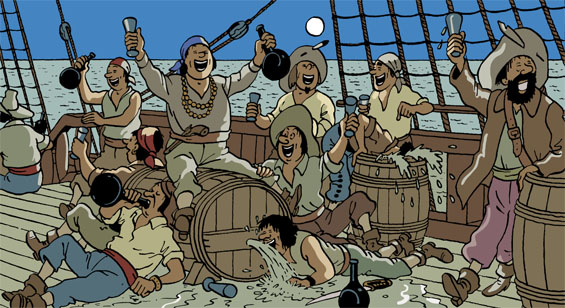Pirates are found only in the Caribbean!

Today, in the Indian Ocean around Somalia; yesterday in the Caribbean Sea; always active in the China Sea. Pirates are everywhere. You can even find them on the internet! Elements of The Red Sea Sharks are still with us today.
The black flag !
Their power? To attack where one least expects them. In the past, their ships were announced by a black flag with skull and crossbones, flying at the top of the main mast. They were so numerous that governments at times fought them fiercely, at others negotiated a temporary peace... but the pirates were always ready to give chase at the least sign of weakness. Over time, pirates of the sea took on a romantic allure. But a resurgence in acts of piracy today, particularly along the coast of Somalia, remind us of a cruel truth: with nothing to lose, pirates are ready to kill to achieve their ends. For the past few months, pirates based in Somalia have been attacking ships sailing in the Indian Ocean from China or the Arabian Gulf, bound for Europe. The situation is serious enough to warrant a military action by the European Union.
Where do pirates come from ?
Pirates have been active for several years along the coasts of China, Malaysia, Australia and in the maze of Indonesian islands. They attack large cargo vessels carrying important goods, including petroleum, which they later sell, and arms to trade with terrorist groups. But Somalian pirates also take food aid intended for regions ravaged by war and famine. That is the main reason for action by the European Union and NATO (the joint defense body comprising Europe and the United States), seen as urgent and indispensible. In all the world's oceans, pirates recruit members among the poorest and most desperate peoples.
Caesar and the pirates
The young Julius Caesar had a run-in with pirates who infested the Mediterranean Sea. His boat was attacked by pirates who took him captive and exchanged him for a large ransom. Freed after payment of an amount equivalent to a million euros, Caesar returned to Rome where he financed a punitive military expedition against the robbers of the sea. The action was decisive: all along the coasts of Italy the Mediterranean became one of the safest areas for sailors! There was nothing pleasant about being captured by pirates during the era from Caesar until the middle of the 19th century. The pirates' first action was to take away all the riches contained in the ship. Next, they identified the richest passengers, with the others being massacred or sold as slaves.
Victims of pirates
During the Middle Ages and up to the end of the 18th century, the Mediterranean was infested with pirates known from the ancient Greek era as "barbarians" or "moors" "Barbarian" was a word used for all foreigners, whereas "moors" referred to the ethnic and religious origins of the Arabs and Muslims from Maghreb (remember that in Arabic the term "Maghreb" means "areas to the west"). These pirates, coming from the south of the Mediterranean, carried out an uncountable number of raids along the coasts of Italy, Greece, Spain and even southern England. Historians estimate that more than a million Europeans were taken to the area that is today's Morocco, Tunisia, Algeria and Egypt, where they were forced into labor building sumptuous palaces or working on irrigation and sewer project - some are even used that way today.
...and in the Caribbean, of course !
Three recent movies (Pirates of the Caribbean) have rekindled our fascination with maritime adventures. It is true that in the 17th and 18th centuries the Caribbean was home to buccaneers (the name for pirates in the Caribbean region, which was called the West Indies at that time). A famous buccaneer preceded all of them: Red Rackham! And in his way stood the knight, Sir Francis Haddoque. The "real" buccaneers could have gone up against an English admiral, Sir Richard Haddock (1629-1715), who was decorated by king Charles II as a reward for his exploits battling England's enemies. The buccaneers of the West Indies created veritable "kingdoms"; they took over an island, made themselves masters and applied their own law. In contrast to popular belief, these "pirate kingdoms" were not anarchies by any means; they were ruled by an iron law, and prisoners without funds worked there as slaves. The situation for women was even worse.
The Red Sea Sharks
Sea-going traffickers can also be found in Hergé's works. In The Cigars of the Pharaoh Tintin and Snowy meet up with them - not exactly pirates, they made more or less the same demands. The Crab with the Golden Claws has other traffickers. Allan is one of them; he succeeds in transforming captain Haddock's peaceful ship into a pirate's haven! In 1956 though, with The Red Sea Sharks, Hergé seriously addressed the subject: piracy still existed in the twentieth century and the pirate's booty included human trafficking. Although he was successful in calling the world's attention to this problem, Hergé could not hide the unfortunate truth: in the 21st century piracy is still active. Obscene poverty in certain regions of the world are pushing entire populations toward banditry.




 News
News Forums
Forums E-books
E-books

